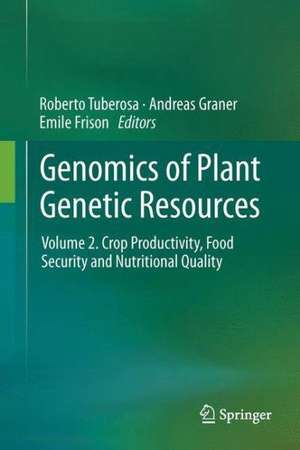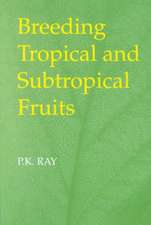Genomics of Plant Genetic Resources: Volume 2. Crop productivity, food security and nutritional quality
Editat de Roberto Tuberosa, Andreas Graner, Emile Frisonen Limba Engleză Hardback – 15 ian 2014
| Toate formatele și edițiile | Preț | Express |
|---|---|---|
| Paperback (2) | 1071.87 lei 38-44 zile | |
| SPRINGER NETHERLANDS – 18 sep 2016 | 1071.87 lei 38-44 zile | |
| SPRINGER NETHERLANDS – 17 sep 2016 | 1228.15 lei 6-8 săpt. | |
| Hardback (2) | 1242.52 lei 6-8 săpt. | |
| SPRINGER NETHERLANDS – 15 ian 2014 | 1242.52 lei 6-8 săpt. | |
| SPRINGER NETHERLANDS – 19 noi 2013 | 1243.78 lei 6-8 săpt. |
Preț: 1242.52 lei
Preț vechi: 1515.27 lei
-18% Nou
Puncte Express: 1864
Preț estimativ în valută:
237.78€ • 246.74$ • 198.75£
237.78€ • 246.74$ • 198.75£
Carte tipărită la comandă
Livrare economică 18 martie-01 aprilie
Preluare comenzi: 021 569.72.76
Specificații
ISBN-13: 9789400775749
ISBN-10: 9400775741
Pagini: 400
Ilustrații: XIX, 515 p. 60 illus. in color.
Dimensiuni: 155 x 235 x 27 mm
Greutate: 1.16 kg
Ediția:2014
Editura: SPRINGER NETHERLANDS
Colecția Springer
Locul publicării:Dordrecht, Netherlands
ISBN-10: 9400775741
Pagini: 400
Ilustrații: XIX, 515 p. 60 illus. in color.
Dimensiuni: 155 x 235 x 27 mm
Greutate: 1.16 kg
Ediția:2014
Editura: SPRINGER NETHERLANDS
Colecția Springer
Locul publicării:Dordrecht, Netherlands
Public țintă
ResearchCuprins
Harnessing plant genetic diversity for enhancing crop production and its sustainability.- Genetics and genomics of flowering time regulation in sugar beet.- Mining the genus Solanum for increasing disease resistance.- Dissection of potato complex traits by linkage and association genetics as basis for developing molecular diagnostics in breeding programs.- Introgression libraries with wild relatives of crops.- High-throughput phenomics tools for interactions of barley with fungal pathogens.- Genomics of low-temperature tolerance for an increased sustainability of wheat and barley production.- Bridging conventional breeding and genomics for a more sustainable wheat production.- Genetic Dissection of Aluminium Tolerance in the Triticeae.- Maintaining Food Value of Wild Rice (Zizania palustris L.) Using Comparative Genomics.- Genomics-assisted crop improvement for food security.- Genomics-assisted allele mining and its integration into rice breeding.- New insights arising from genomics for enhancing rice resistance against the blast fungus.- Enhancing abiotic stress tolerance in plants by modulating properties of stress responsive transcription factors.- The Borlaug Global Rust Initiative: Reducing the genetic vulnerability of wheat to rust.- Genomes, chromosomes and genes of the wheatgrass genus Thinopyrum: the value of their transfer into wheat for gains in cytogenomic knowledge and sustainable breeding.- Identification and implementation of resistance: Genomics-assisted use of genetic resources for breeding against powdery mildew and Stagonospora nodorum blotch in wheat.- G6nomics-assised crop improvement for nutritional quality.- Breeding for apple (Malus × domestica Borkh.) fruit quality traits in the genomics era.- Enhancing nutritional quality in crops via genomics approaches.- N. Genomics of mineral nutrient biofortification: calcium, iron and zinc.- Optimising the content and composition of dietary fibre in wheat grain for end-use quality.- TILLINGfor improved starch composition in wheat.- Molecular Breeding for Quality Protein Maize (QPM. Index.
Textul de pe ultima copertă
The future of food security will increasingly rely on more extensive exploration and effective exploitation of plant genetic resources. The remarkable progress in plant genomics, sequencing and bioinformatics offers unprecedented opportunities for mining germplasm collections, mapping and cloning loci of interest, identifying novel alleles and deploying them for breeding purposes.
Genomics of Plant Genetic Resources presents a state-of-the-art collection of highly interdisciplinary articles describing how genomics improves our capacity to characterize and harness natural and artificially induced variation in order to boost crop productivity and provide consumers with high-quality food. In the past decade, the appreciation of the value of biodiversity has grown rapidly, mainly due to the increased awareness of the pivotal role that plant genetic resources plays for securing the supply of plant-derived products. Meeting the challenges posed by climate change and the needs of the burgeoning population will require a quantum leap in crop productivity, which will only be possible through the integration of genomics-based approaches with extant breeding programs. Additionally, the new selection paradigm ushered in by genomics-assisted breeding will facilitate allele mining in orphan crops and underutilized species, previously less accessible via conventional approaches. The unifying picture that emerges from this book unequivocally shows the pivotal role played by genomics in order to mine germplasm collections, elucidate gene function, identify superior alleles and, ultimately, release improved cultivars. For each of these objectives, the book presents a number of compelling case studies and examples. This unique and timely book is an invaluable reference for educators, researchers, crop specialists, breeders and decision makers interested in managing, mining and harnessing the genetic richness of plant geneticresources.
Genomics of Plant Genetic Resources presents a state-of-the-art collection of highly interdisciplinary articles describing how genomics improves our capacity to characterize and harness natural and artificially induced variation in order to boost crop productivity and provide consumers with high-quality food. In the past decade, the appreciation of the value of biodiversity has grown rapidly, mainly due to the increased awareness of the pivotal role that plant genetic resources plays for securing the supply of plant-derived products. Meeting the challenges posed by climate change and the needs of the burgeoning population will require a quantum leap in crop productivity, which will only be possible through the integration of genomics-based approaches with extant breeding programs. Additionally, the new selection paradigm ushered in by genomics-assisted breeding will facilitate allele mining in orphan crops and underutilized species, previously less accessible via conventional approaches. The unifying picture that emerges from this book unequivocally shows the pivotal role played by genomics in order to mine germplasm collections, elucidate gene function, identify superior alleles and, ultimately, release improved cultivars. For each of these objectives, the book presents a number of compelling case studies and examples. This unique and timely book is an invaluable reference for educators, researchers, crop specialists, breeders and decision makers interested in managing, mining and harnessing the genetic richness of plant geneticresources.
Caracteristici
The book presents a unique synopsis of state-of the-art articles that no other book can offer Provides the reader with compelling examples on a very hot topic World renowned authors have contributed to this unique book A must for all those engaged in managing and studying plant genetic resources Includes supplementary material: sn.pub/extras






